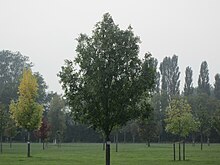Thedinghausen Hereditary Farm
The Thedinghausen Erbhof is a manor in the Thedinghausen community in the Verden district of Lower Saxony . It was built from 1619 by the Evangelical Lutheran Archbishop Johann Friedrich von Bremen for his lover in the Weser Renaissance style.
history
The Archbishop of Bremen from the house of Schleswig-Holstein-Gottorf met Gertrud von Hermeling-Heimbruch here in 1612 on the hereditary farm of her husband Heinrich Corlehake Hermeling. Henry bequeathed in 1613, a year before his death, the ruler until then lehnsfreie property, Johann Friedrich appointed in return for the landowner Drosten of offices Thedinghausen and Langwedel . After his death, the archbishop built the manor house for the widow, his now lover, as a befitting residence. Gertrud also died during the construction work, on March 16, 1620. It is probably due to their death that the conversion of the former hereditary courtyard, originally planned only as a pleasure palace , was expanded to form the archbishop's country palace with the two outer lofts and the addition of representative architectural decorations. Since then, the two-storey brick building has been characterized by three protruding risalits or cantilevers on the main facade. The middle one contains a spiral staircase , which, as can be seen from the construction seams, belong to a slightly later construction phase. Richly decorated gables, frames and pilaster strips made of sandstone structure the unplastered outer surfaces. Portrait medallions show several times the portrait of Gertrude and her lover. In the history of ornamentation, the individual forms ( scrollwork and tailwork with a tendency towards cartilage ) are already at the transition from Mannerism to early Baroque. The interior has been largely changed.
In 1621, immediately after completion, the archbishop gave the estate to his son Friedrich, after whose death his sister Christine inherited it; Both had emerged from a love affair between the archbishop and the middle-class Anna Dobbel from Bremervörde. Christine von Holstein sold the estate in 1649 to the Swedish Count Arwed von Wittenberg, who died in 1657. His daughter, the young Countess Marianne Margarethe von Wittenberg, now became the owner. Their guardians sold the farm in 1681 for 11,000 Reichstaler to the Swedish Drosten in Verden, Thomas von Gerstenberg. His son and successor, Heinrich Wilhelm von Gerstenberg, was married to Katharina von Klencke from the Donnerstedt family. The eldest daughter of the two, Metta Beate, married to District Administrator Karl-Ludwig von Meihern, inherited the farm. This later fell to the family of Ompteda related to them due to childlessness. In 1785 the estate went bankrupt and again in 1813.
In a public auction in 1829, the estate came into the hands of the Celle bailiff (bailiff) Christian Lüders. In his family he passed on to this day. From 1885 to 1935, his descendant Theo Lillie managed the estate. He also had a great influence on local politics in Thedinghausen, popularly known as the "Duke of Thänhusen". His daughter Louise Lillie married the bank director Henrich Kriete in 1921. The eldest son Edmund Kriete took over the agricultural property after World War II. Due to the bankruptcy of the Thomas Kriete "Transport - Building Materials - Earthworks - Rental" company, the Erbhof also got into the bankruptcy fair in 1998. At the auction in 1998, the main creditor, the Kreissparkasse Verden, acquired the estate. She sold it on to the Thedinghausen community, which has been the owner since January 1, 1999.
From 2011 to 2014 extensive restorations and reconstructions were carried out. They included an extensive upgrading of the roof structure, a renewal of the slate roof with "old German cover" , the restoration of the "Renaissance hall" with new tiling according to the existing pattern, exposure and restoration of the ceiling beam painting and a partial reconstruction of the fireplace. Even if the building is largely attributed to the “ Weser Renaissance ”, it should be noted that its style already bears predominantly early Baroque features. An 11 hectare tree park , an arboretum , supported by a foundation , adjoins the castle.
literature
- Thedinghausen - hereditary farm, so-called castle. In: Georg Dehio : Handbook of German Art Monuments . Bremen Lower Saxony. Munich / Berlin 1992, p. 1270 f.
- Fritz Garvens : The hereditary farm in Thedinghausen. Ed .: Heimatverein der Samtgemeinde Thedinghausen, Heimatverein, Thedinghausen 2001; ISBN 3-931699-06-4
- Ernst Andreas Friedrich : The Thedinghausen Hereditary Farm in: If stones could talk . Volume IV, Landbuch-Verlag, Hannover 1998, ISBN 3-7842-0558-5
- Christine Bernheiden: The Thedinghausen Hereditary Farm . In: Building decoration as an educational claim, (= materials on art and cultural history in North and West Germany - Volume 5), Marburg: Jonas, 1993
Web links
Coordinates: 52 ° 57 '40.6 " N , 9 ° 1' 49.9" E


